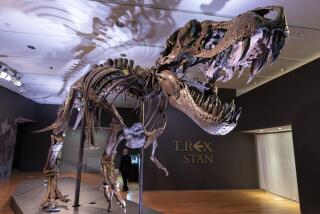Fuzzy fossil may indicate most carnivorous dinosaurs had feathers
A 135-million-year-old fossil of a juvenile dinosaur found in Bavaria suggests that most carnivorous dinosaurs may have been covered in feathers.
Paleontologists had already known that many dinosaurs closely related to birds were covered in feathers, but the newly discovered one is from a different family and occurs much earlier in the dinosaur evolutionary tree. Because of the early appearance of feathers, the find indicates “that all predatory dinosaurs had feathers,” said paleontologist Oliver Rauhut of the Bayerische Staatssammlung fur Palaontologie und Geologie in Munich, who led the team.
The fossil, whose discovery was reported in the Proceedings of the National Academy of Sciences, was found in the limestones of northern Bavaria, the same site where the first feathered dinosaur -- Archaeopteryx -- was discovered 150 years ago. The fully intact skeleton is a juvenile of the species and is about 28 inches long. It was frozen in time with its mouth wide open, revealing small, sharp teeth. It also has a bushy tail covered with fine, fuzzy hairs that are thought to be feathers. Because of the tail, researchers named it Sciurumimus albersdoerferi, which is derived from the scientific name for the family of tree squirrels, Sciurus. It is a megalosaur, unlike all previously discovered feathered dinosaurs, which are coelurosaurs. Coelurosaurs are a diverse group that includes Tyrannosaurus rex and birds.
Adult megalosaurs reached about 20 feet in length and often weighed more than a ton. They were active predators, hunting other dinosaurs and smaller prey. The juvenile specimen, which represents the most complete predatory dinosaur ever found in Europe, probably hunted insects and other small prey, as indicated by his sharp teeth. It is also notable for its large eyes.
“Everything we find these days shows just how deep in the family tree many characteristics of modern birds go, and just how bird-like these animals were,” said Paleontologist Mark Norell of the American Museum of Natural History in New York, a co-author of the paper. “At this point, it will surprise no one if feather-like structures were present in the ancestors of all dinosaurs.”
Twitter/@LATMaugh






